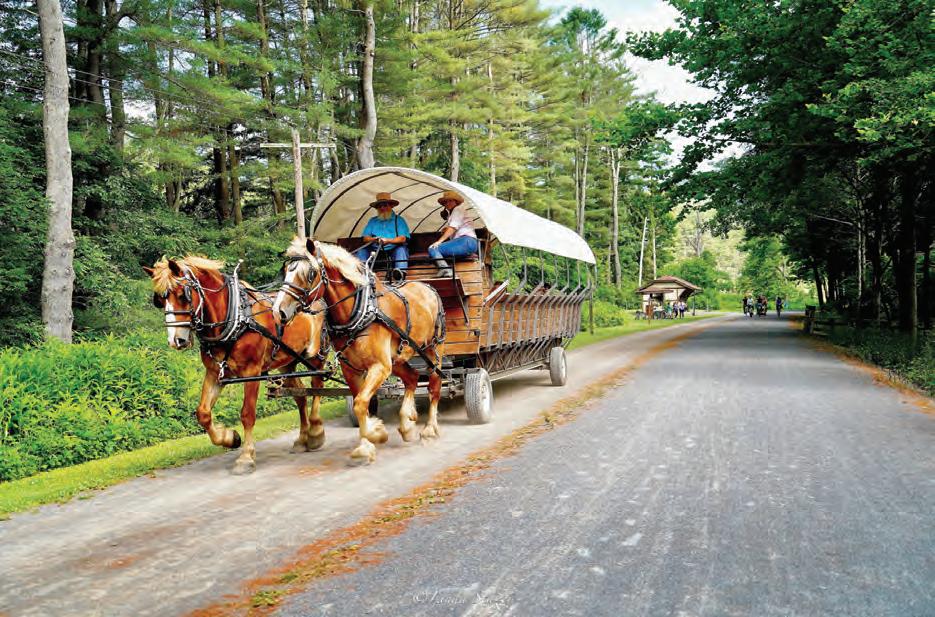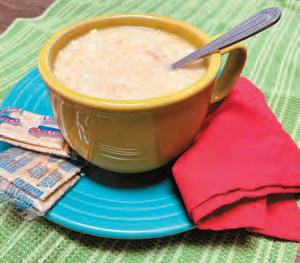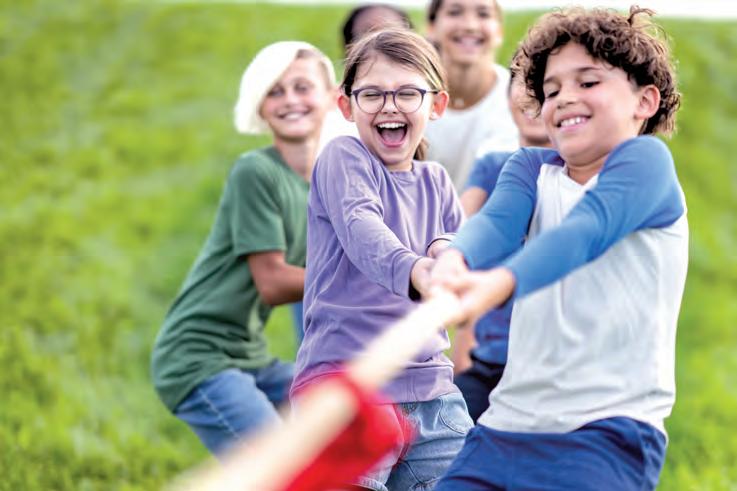













PUBLISHER
Jocelyn Engle
CONTRIBUTING WRITER
Cat Shannon
COVER
Ashley Kendrick Kennedy
CREATIVE
Melissa McKee
ADVERTISING SALES MANAGER
Greg March























PUBLISHER
Jocelyn Engle
CONTRIBUTING WRITER
Cat Shannon
COVER
Ashley Kendrick Kennedy
CREATIVE
Melissa McKee
ADVERTISING SALES MANAGER
Greg March








By Cat Shannon


Touring a farm, such as Eastland Alpacas, provides hands-on opportunities for fun - and giggles.
How many times a day do you look at your cellphone? And what about your children - how often are they staring at a screen?
Spending too much time on cellphones, computers, gaming or watching TV can have adverse effects on children’s health.
“One of the things that happened for the very young child during COVID was that babies did not learn how to interpret facial emotions, because everyone was wearing a mask and the mouth could not be seen,” shared Jan Betty, director of children and youth for the Milanof-Schock Library in Mount Joy. “It’s that way with online gaming. You can converse online, but you aren’t speaking to a real person and really can’t judge emotions, because the face, especially the mouth, wasn’t visible. And since COVID, Zoom has become almost the norm for adults and kids - more screen time!”
Betty said getting outside and away from screens can reduce stress, encourage friendships and boost imagination.
“Doing a physical activity such as hiking or even just walking with friends or family is good for building social skills, besides being great for you physically,” she said. “Now I text a lot, probably more than I should, but it concerns me when I see two young people sitting together and texting to each other when they could be having a great conversation face to face.”
It can be challenging to pry kids away from their screens. We’re all guilty of giving in to screen time to keep kids entertained easily, and children have made screen use a daily habit that’s hard to break.
It may be difficult to reduce screen time with your kids, but it’s not impossible. Lucky for you, Lancaster County has a plethora of ideas for unplugging this spring and summer. Check out these options:
Encourage your children to keep a summer journal, where they can write about their adventures, draw pictures or document interesting things they discover. At the end of the summer, have a family reveal where you share your journals and relive your favorite summer memories.
If you’re feeling really creative, start a family newspaper and have your kids write, illustrate and publish it weekly, detailing family summer highlights. Or get kids started with creative writing by providing fun prompts such as “If I could invent a new amusement park ride, it would be …”
We’re blessed to live in a county that’s rich in agriculture. Take advantage of farm tours offered at places like Verdant View Farm in Paradise and Oregon Dairy in Lititz, or check out Eastland Alpacas in Mount Joy.
“Visiting with the alpacas is a fun activity where you will learn about the alpacas,” said Sue Zurin, who owns the Eastland Alpacas with her husband, Kevin. “(Kids) will be able to hand-feed them and take lots of pictures. You will also learn what we do with the fleece and how we have it made into yarn and woven rugs and send to a co-op here in the United States where they make products for us to sell in our store.”
The farm typically houses about 90 alpacas, and tours are offered by appointment. A Fall Open House is held over the first two weekends in November.
Take your kids to remote parts of the county, away from light pollution, and check out the summer sky. Bring a star map with you and see what you can identify in the space above you. Or head inside to the planetarium at the North Museum of Nature and Science in Lancaster or the Ryan Observatory at Muddy Run in Holtwood.
Try simple experiments in your backyard, like making a solar oven to cook s’mores, creating the world’s biggest bubbles with homemade bubble solution or growing a crystal garden. Find inspiration at https://tinybeans.com/simplebackyard-science-experiments.
Libraries encourage reading, of course, with books for people of all ages, but there’s more to discover than just what’s between the pages, Betty said.
“We have interactive backpacks for educational play, puzzles and even telescopes to lend to patrons,” she stated. “I have a real passion for families who try to do things together. And many of my programs are family oriented. Watching families build blanket forts in the library, then read together in them or work on a Lego challenge together really makes me smile.”
Consider joining your library’s Summer Reading Program, which will begin on Saturday, June 7. This year’s theme is “Color Our World.”
“We offer so many programs during the summer to keep minds engaged,” Betty remarked. “Art, story times and lots of guests make summer extra special at the library. Of course, there’s also the Summer Reading Program reading sheets to keep everyone reading during the summer, preventing that summer slump. And many of the programs are for families to give them a chance to spend some quality time together.”
The Library System of Lancaster County also hosts a countywide parks program, encouraging people to travel to parks to find a special post with a raised shape on it. “There’s a sheet provided to lay over the raised shape and do a rubbing with a crayon or pencil, making the shape appear on the paper,” Betty said. “The booklet provided by the library contains the locations of about 30 parks with a difficulty rating for the hike and other info in each one. Lots of families pack a lunch and enjoy time together at each park.”
Cook together with your kids and discuss how measuring ingredients adds up to math. Count fireflies in the backyard or create a play store in your home and encourage kids to use play money to buy items.
At Verdant View Farm (pictured), families can explore a working farm and participate in activities.



With six regional parks and three recreational trails, the Lancaster County Department of Parks and Recreation manages more than 2,000 acres and provides numerous opportunities for families to get outdoors.
“It is important for kids to get outside and experience outdoor activities because children can’t truly care for something, whether it be wildlife, ecosystems or recreational activities, until they experience it,” said Lisa Sanchez, senior park naturalist. “Outdoor experiences build passion and love for the environment. Natural sunlight is important for mood stability, and by experiencing the outdoors, they build a connection to the environment that could lead to an effort to conserve nature.”
Structured programs offered by the park are great, she said, but unstructured play outdoors has positive benefits on mental development.
“This type of play allows for creativity, exploration, problem solving and open-ended play,” she said.
Summer programs offered by the Parks and Rec department include birding, canoeing, full moon walks, fishing and more. A full list may be found at https://bit.ly/43p6Q9K.
“Regional parks range in level of development from Central Park’s more urban setting to the Theodore Parker Natural Area’s rural setting in the woodlands along Stewart Run in the southeastern part of the county,” Sanchez said. “Our parks provide educational and recreational opportunities for all ages and abilities.”
She noted that Central Park and D.F. Buchmiller Park, located just outside of Lancaster city, have the most recreational opportunities. Amenities include baseball and soccer fields; basketball, tennis and pickleball courts; equestrian trails; disc golf; a skatepark; playgrounds; garden plot rentals and the Garden of Five Senses at Central Park; and a community pool in Central Park.
Numerous trails throughout the county provide flat surfaces for walking, running or biking, including the Conewago Recreation Trail, the Lancaster Junction Recreation Trail, the Northwest Lancaster County River Trail and the Conestoga Greenway Trail.

“Chickies Rock, a massive outcropping of quartzite rock towering 100 feet above the river (has) a vista that offers impressive views of York County, the borough of Marietta and farmlands of northwestern Lancaster County,” Sanchez shared, noting that other unique spots include Speedwell Forge County Park, located north of Lititz, and Money Rocks County Park, located in the Welsh Mountains of eastern Lancaster County.
A full list of parks and more information may be found at www.co.lancaster.pa.us/151/ Parks-Recreation.





























Using professional cleaners, like these staff members at MaidPro of Central PA, can jump start your house cleaning and encourage you to keep going.
By Cat Shannon
Spring cleaning doesn’t have to be an exhausting or timeconsuming chore. By planning ahead, getting the whole family involved and using efficient cleaning strategies, even the busiest families can enjoy a fresh and organized home.
“I’m a firm believer in the idea that if you have a cluttered/chaotic home, you have a cluttered/chaotic mind, and on the flip side, if you have a clean home, you have a calmer mind,” said Stephanie Klein, professional organizer and owner of Cozy & Clutter Free Organizing in Lancaster. “You own your stuff - your stuff shouldn’t own you. … Being a parent is a difficult job - some might say the most difficult job - and having an unkempt home certainly doesn’t make things easier. You and your kids will thrive so much better in a clean and tidy space.”
Nichole Kambesis, owner of MaidPro of Central PA in Lancaster, Hershey and Camp Hill, said involving children in cleani ng can make a long-term impact.
“I am the mother of three grown children,” she said. “They still talk with pride and laughter about their Saturday morning chores. Children want to help and have that accomplishment under their belt.”
In fact, Klein said, research points only to the benefits of involving children in age-appropriate chores. Kids gain a sense of responsibility, improved self-reliance, increased self-esteem, a good work ethic and valuable life skills - and you get a clean house!
But where do you start? How do you get your kids involved in cleaning, and what age is the right age to begin?

Here’s some advice from the experts:
“Start small with age-appropriate tasks and build upon those tasks as your child grows,” Klein advised, noting that children as young as 2 can engage in simple household chores. “Toddlers can help put their toys away or wipe off the dining table after a meal. Preschoolers can set the table or help with laundry, sorting clothes or loading stuff into the washer. Elementary kids can unload the dishwasher or put away their laundry. Middle-schoolers can take out the trash or vacuum. High-schoolers can dust or clean bathrooms.”
“When my kids were young, they helped me with my chores,” Kambesis said. “If I was cleaning the bathtub, my younger child was cleaning the sink. I would have to redo a lot! If I was cleaning, my young child was cleaning, too.”


Cleaning of any type will reduce dirt and germs, remove clutter and provide children with a healthy, relaxed home atmosphere, she said, adding, “It’s not about perfection, but a decently clean home gives everyone a better shot at thriving.”
Kambesis said many of her clients ask for “catch-up” cleanings to get started and then plan to maintain their home going forward. She emphasized that even for busy parents with a long list of activities their children participate in, a clean home is possible.
“Getting your kids to clean should be on that list, but it falls to the side because boy, there are only so many minutes in the day!” she said. “That’s why I loved Saturday morning chores - one hour of your kids getting their home clean is attainable.”
“In general, I think kids are more capable than we give them credit for,” Klein shared. “My kids have loved helping with laundry, wiping down tables, emptying the dishwasher or running the vacuum from a fairly young age. … If you’re looking to get your kids involved for the first time, think about the tasks that need done around your
house on a daily or weekly basis, and then consider which of those tasks could be done by one of your children.”
Put on music or create a game out of cleaning, Klein suggested. Set a timer for five or 10 minutes and see how much they can clean before the buzzer goes off.
Create a treasure hunt by hiding small rewards or stickers around the room for your kids to collect as they clean.
Challenge each other to see who can put away the most toys or sort the laundry faster.
Give kids their own cleaning tools, whether it’s a kid-size broom or a colorful apron, so they feel like they’re part of the team.
Incorporate your child’s interests. If your daughter loves superheroes, for example, pretend she’s “saving the house from dust villains.” If your son likes cars, have him “drive” each laundry basket to the right room.
“Kids also need to start understanding that there is a whole world of germs that they cannot see. Some of them are good for us, but some are really bad for us,” Kambesis said. “Spring cleaning is a wonderful way
•
•
•

Cyrus R. Peters Memorial Post 5956 Manheim VFW
149 S. Charlotte St. Manheim, PA 17545
“NO ONE DOES MORE FOR VETERANS”
We welcome everyone in the Community to pay us a visit and hopefully join our club.


to make everything look new, to disinfect and to mimic a sense of mental renewal for ourselves. Look and clean what is underneath. Step up on that ladder and clean what is on top. Clean that cabinet door, that kitchen door. Clean that utensil drawer that mysteriously collected debris somehow. And when you and your kids are all done, you can revel in your accomplishment and relax with the physical exertion.”
“Keep the jobs quick and easy and give them praise or a high five when they complete a task,” Klein said. “Thank them profusely for being such a good helper to Mom and/or Dad, and watch their chest swell with pride!”
You can even create a sticker chart for your child to earn rewards, like going out for ice cream, once their chores are complete, she said.
Kambesis provided an allowance to her children when they finished their chores.
“A clean home is attainable,” Kambesis said. “Small tasks done daily, and other tasks done weekly, need to be a life chore, no different than brushing your teeth.”
“These skills are ones your child is going to need for the rest of their life,” Klein remarked. “If you send your child off to college and they’ve never once had to do their laundry or clean a toilet or take out the trash, I can almost guarantee that they will have a hard time thriving as an adult and maintaining a clean/tidy home in the future.”
Kambesis knows firsthand this is true.
“Now, my adult children know how to clean as well as I do,” she said. “They love having a clean house and feel better mentally if their space is clean and in order. I learned from my mother and grandmother how to clean, and I am very happy that I taught my own children this important life skill.”






























It is common for individuals to think that the ultimate vacation adventure requires venturing far afield, but there is plenty of summer fun available closer to home, as well.
Families may visit an amusement or a theme park. Spending a day or two at one of these destinations can introduce them to different rides, sights, attractions, food, and people. Waterparks, summer carnivals, and local theme parks also can make for fun excursions.
People might consider finding out where the highest peak near them is and then hike to the top. They may find stunning views.
Experiencing a new culture is possible close to home by eating at a restaurant that serves food from a country one has never visited. Many dishes and even specific ingredients may be new.
People may go rafting or tubing. These activities range from a lazy float down a slow-moving stream to the excitement of hurtling over rapids as the landscape rushes by.
Other water sports are also an option for adventure. Stand-up paddleboarding or kayaking can be entertaining ways to enjoy the water, and they provide a workout for many parts of the body.
Fishing is a great summertime activity. Some of the best times to fish are at dawn and dusk when fish are more likely to bite. Make sure you have a fishing license if needed. In Pennsylvania, anyone age 16 and up is required to have a fishing license in order to fish. Licenses can be purchased at www.huntfish.pa.gov.
The summer months are a good time to take a dip as the water becomes a more comfortable swimming temperature. Families may head to a local swimmable body of water and hop in. People are advised not to swim in secluded locations and to check for warnings related to currents and weather. They should keep an eye out for aquatic life, as well.
One more close-to-home summer adventure may be catching a baseball game. In addition to watching Major League Baseball, people may purchase tickets to minor league games; these tickets may be easier to come by and softer on the wallet.
Summer adventures do not have to require traveling far. There are plenty of exciting activities close to home.



























Social media has its fair share of proponents and detractors. The advisory firm Kepios reported that at the start of October 2024, there were 5.22 billion social media users around the world, which translates to roughly 64% of the global population. However, some people see social media as a largely divisive entity that may have an adverse effect on the physical and mental health of its users.
Helping children safely navigate social media is no small task, but finding a way to do so can have a profound impact on youngsters' health. The American Psychological Association (APA) offers recommendations to parents and caregivers who are concerned about the safety of youngsters using social media.
Adults should recognize social media features that can be especially harmful. The APA notes that children can learn new social skills and communication strategies on social media, but some components of the technology may be particularly detrimental to children's
still-developing brains. The APA highlights “like” buttons and the use of artificial intelligence as particularly harmful features because they promote excessive scrolling. Adolescents may be especially vulnerable in this regard, as the APA notes that the brain undergoes dramatic developmental changes during adolescence, when areas of the brain associated with a desire for attention from peers become increasingly sensitive. Social media can exploit that need, which is even more dangerous because the parts of the brain that govern self-control do not fully develop until early adulthood. Parents can limit usage of platforms that tally likes and set screen limits to minimize excessive scrolling.
The APA urges parents to monitor their children's social media usage, particularly during early adolescence. They should also maintain a dialogue with children about their social media usage, which can help youths navigate its dangers more effectively. Engaging youngsters each week also can make them feel more safe and not

as though they are being judged about their usage. Adults and children can discuss what they see on social media, and parents may present hypothetical situations that may unfold on social media and ask children how they would respond.
As in many areas of life, parents should lead by example. Children learn many of their behaviors from their parents, so if their parents exhibit poor social media habits, then youngsters may follow suit. The APA urges parents to avoid scanning social media during meals and family time. Parents also can selfgovern their own usage, setting the same limits on time for themselves as they set for children. Periodic breaks from social media usage are also a healthy idea.
Parents have a big task ahead of them in regard to helping kids safely navigate social media, but various strategies can increase the chances that kids have a positive social media experience.
Eric B. Phillips certified public accountant



























Many children enjoy receiving – getting presents at birthdays and other holidays and earning special treats at school or at home. But parents likely also want to teach their children the importance of giving to others, and one way to do so is to get kids involved in volunteerism.
Volunteering can give kids a broader perspective, making them aware of the needs of others both in their communities and around the world. Volunteering can help to instill empathy in children that can lead them to become good citizens, and a higher level of compassion may also help children interact better with peers. Volunteering can also teach children that even at a young age, they have the power to make a difference.
One way for parents to get kids excited about volunteering is to become role models. Children are inspired by their parents and learn how to follow their lead. If children see their parents as active volunteers, they may be more likely to volunteer themselves. According to Volunteers of America, when a parent or guardian is involved, a child often looks forward to the volunteer activity even more.
Parents can also make volunteering a routine. Children go to school or sports on a consistent schedule, and a structured schedule can be advantageous to kids. A consistent volunteering schedule can help children keep a routine when there is more unstructured time, such as during the summer and on weekends.
Kids may be encouraged to try volunteer work that aligns with their interests and aptitudes. An activity that aligns with kids’ hobbies or passions may increase the likelihood of children remaining engaged with volunteering.
Activities can also be chosen based on kids’ attention spans. A quick activity like picking out a gift for a child in need can be done in a short amount of time, while other activities can take all day.
Volunteering can be made more fun when challenges or games are incorporated. Participants may see who can pick up the most litter or make the most sandwiches at a food pantry.
Parents can celebrate and acknowledge kids’ efforts, no matter how small they seem. Positive feedback can encourage kids to continue their involvement in volunteer work.
Parents and other caregivers can help children to develop a passion for volunteering that can continue throughout their lives.






Featuring one of life’s most savory and delicious comfort foods, join with those who have discovered the “from-scratch” meat pies that are made at Zook’s Homemade Chicken Pies. Surrounded by Amish farmlands in the heart of the PA Dutch countryside, this family owned and operated business uses special mouth-watering recipes that are making their beef, chicken, and sausage pies more famous with each passing year.
From the humble beginnings in their Amish farmhouse kitchen to a USDA inspected commercial enterprise, the quality and taste of their pies remains the same, even as the distribution has increased from one market stand to multiple stores and farm markets throughout Pennsylvania and surrounding states.
You are always invited to stop by the Zook’s retail store to stock up on these quick and easy meals that are tasty and nutritious too! In addition to meat pies. Zook’s has a nice selection of specialty food items, including homemade soups, bake-at-home meals and fresh bakery items.








The Lititz Shirt Factory has undergone a multi-million dollar transformation from a turn-of-the-century brick clothing factory to a contemporary rustic but chic restaurant taproom and entertainment venue. Located just one block from the picturesque town square, The Shirt Factory, in partnership with Collusion Tap Works, offers an affordable opportunity to host your wedding, birthday party, family reunion, business meeting, or corporate gathering. This unique two-tier space consists of a large main floor and a 2nd-floor loft.


This space can be customized for almost any event and includes a fully-staffed 16-tap bar, serving finely crafted beers, wine, and cocktails. The full stage comes equipped with a professional sound system for dance bands or business presentations. We are dedicated to ensuring your event is special whether for a small gathering of 25 or a large affair for up to 100 people.
Collusion Tap works skilled kitchen staff offers many delicious catering options.


Millions of children spend time at camp each summer. The American Camp Association reports that 26 million children enroll in summer camp each year, and many of those youngsters make memories that last a lifetime while building friendships along the way.
In recent decades, camps may have become even more important as more households have featured two working parents. Single-parent households may also rely on summer camp to keep kids occupied while the parent works.
Camp benefits children in myriad ways, such as providing opportunities to socialize throughout summer. While children in high school might be independent enough to
come and go with their friends during summer break, kids who are still in elementary school or middle school might not be old enough to handle such freedom. That can make it hard to stay in touch with friends, which in turn can contribute to feelings of boredom and loneliness. Camp provides ample opportunities for young children to socialize during a time of year when they might not see their school friends as often as they are used to.
Although some summer camps are exclusive to residents of certain communities, many tend to host children from numerous towns or municipalities, potentially offering an opportunity for campers to interact with peers who come from different backgrounds. Indeed, the Graduate
School of Education at Harvard University notes that summer camp may be the first time children spend substantial amounts of time with people whose backgrounds differ from their own.
Camps also offer opportunities to get kids off their devices. Modern children are growing up in a digital world, and parents know how hard it can be to get kids to put down their devices and get outdoors. But the key to making that switch could be access to outdoor play spaces. A 2025 study from researchers at the University of Michigan published in the journal Health & Place found that efforts to reduce kids' screen time are more successful when children are given a chance to play outside. Luckily, many summer camps are structured around outdoor play. Children who do not attend camp and live in households where both parents work or in singleparent households where their parent works may be forced to spend much of summer indoors, which could increase the frequency with which they turn to devices to occupy their time.
Camp adds structure to summer days. Once a school year ends, the structure a school day provides vanishes, and extracurricular activities go on hiatus. Kids accustomed to structure may be left with little to do and no need to schedule their time. Camp can provide the structure kids are accustomed to but still offer a break from responsibilities like homework or the commitments required of extracurricular activities.
When choosing a camp for their children, parents may consider several factors. For example, they may inquire about hours of operation, insurance, and pricing.
They should also be sure to find out about eligibility. Some camps limit enrollment to youngsters within a predetermined age bracket, while others may be exclusive to legal residents of the town where the camp is being held. Eligibility is not only a significant variable in regard to determining who can attend a given camp; it is also notable because parents may want their




children to attend a camp that will feature some familiar faces. Attending camp alongside classmates, neighbors, or teammates can calm kids' nerves and make them more excited about going to camp. But camps open to children from other towns also can allow children to expand their social networks.
The history of the camp may also be considered. A camp that has been in business for decades is not necessarily superior to one that opened more recently, but it may still be worth asking how long a camp has been around. Camps that have been around longer may have a significant number of Google reviews and may even provide testimonials from past campers and parents. They may also be able to share information regarding their return rate, which indicates the number of youngsters who have come back in subsequent summers. A strong return rate may indicate children enjoy their camp experiences.
The experience levels of camp staff members may influence parents’ decisions. Camp directors and staff members spend a lot of time with campers each summer, so it is important that parents ask who these people are, how they are trained, and how much experience they have. Although no business can avoid employee turnover completely, questions about turnover rate, training, and the counselor selection process are reasonable questions to ask prior to enrolling a child in a particular camp.
Parents may want details about the camp itinerary. Kids might grow bored if the camp features the same itinerary each day, and parents might feel such camps are not worth the investment. Parents may ask about the typical camp itinerary, including field trips, daily activities, special events, and entertainment. The more entertaining and fun a camp is, the more likely youngsters are

to love spending time there.
Another possible question is how much physical activity is included, as physical activity is a vital component of a healthy lifestyle and a great way to make the best of the summer sun. Sports camps will likely feature lots of physical activity, but other camps, such as academic camps or arts-related camps, may also include some. Summer camps will be up and running before parents know it. Camps can hold significant benefits for children, and asking the right questions can help parents identify the best camp for their children.













Gardening is a popular hobby around the world. RubyHome Luxury Real Estate estimates there are 71.5 million gardening households in the United States alone. That translates to about 185.9 million people engaged in some form of gardening, which places the U.S. among other countries where gardening is popular, including Australia and China.
Gardening is a rewarding hobby that is good for the mind and the body. Those who are new to gardening may want some pointers to get started.
Those new to the activity should spend time in their yard and decide where to plant a garden. A far-off corner may get the most sun, but some people may forget about the garden if it is too

far away. The amount of time plants need to be in the sun each day depends on the varieties of plants chosen for the garden; seed or plant packaging usually includes recommendations. There also should be a water source nearby, and the spot should be convenient so that it is easy to pick vegetables or prune flowers.
It is advisable to begin with a small garden footprint. A raised garden bed can be a good starting point because it is contained and easy to maintain. As a person’s experience and garden grow, he or she may want to expand the garden’s borders.
Gardeners may need to amend the soil. It is possible but unlikely that the soil in the backyard is the perfect
mix to grow healthy plants, so soil modifications may be needed. People can test the soil makeup with do-it-yourself kits or work with a garden center. A garden typically requires a mix of compost to add nutrients to the dirt, peat moss or coconut coir to help with water retention and to make the soil lighter, and vermiculite to help retain water. A compost bin set up at the same time as the garden allows gardeners to continually produce nutrientrich food to add to the garden.
When planning the garden, think about what will grow well in the area’s climate. Consider how big the garden will be and the size of mature plants. A very small garden will not be able to accommodate corn, for example. People may

also decide how they would like the space to look and what its function will be. They may hope to create a purely aesthetic garden, or they may want to grow food.
If starting a garden from seeds, it is best to plant them indoors before the region's frost-free date. This way the delicate plants can get the needed care and become established before they go outdoors in the ground. Gardeners should keep the seedlings humid by covering them in plastic wrap. People can start the seeds in various kinds of containers, even empty egg cartons. After the seedlings grow a second set of leaves, they can be transplanted to larger containers. Once the ground is free from overnight frost, the established seedlings can be placed in the ground.
An automatic watering system, such as a timer hooked up to a sprinkler, can keep a garden properly watered, which increases the chances of success. Then it will likely only be a matter of weeks before the garden can be enjoyed throughout the season.

















Free Kid’s Activities
•Balloon Artist: 10 am to noon
•Clyde Peeling’s Reptiland Show at noon
•Face Painting: 1 to 3 pm
• Mascots throughout the day:
•Echo, the bat from Lincoln Caverns
•Chipper from Herr’s Chips
•Johnny, the Long John from Achenbach’s Pastry
Special kid’s rafFle!



Exhibitors from destinations and attractions from all across PA will have information to help you plan your next getaway in Pennsylvania! No sales, just free info, exhibitor raffles and ideas for your next family vacation.
One lucky attendee will win the Grand Prize $2,000 Getaway for 4 in Potter and Tioga Counties - lodging, attractions and dining and more! Rain or Shine








Physical activity is an important component of health, both for adults and for children. The Centers for Disease Control and Prevention recommends that all children and adolescents get at least 60 minutes of moderate to vigorous physical activity each day. This goal will likely be easily met by youths who are involved in competitive sports, but it may seem to be a more difficult task for non-athletes. However, a number of physical activities other than organized athletics are available to ensure kids get all the exercise they need.
Dance is a popular physical activity for young people. It is a versatile form of exercise with options ranging from the ballet, jazz, tap, and modern dance taught at many studios to ballroom dancing and even line dancing. The National Institutes of Health (NIH) notes that dancing is both an exciting and effective workout that benefits the body in myriad ways. The NIH notes that it is a great cardiovascular exercise that also helps to build strong bones and muscles and improve balance. Dancing also is a social activity, which gives it further health-related benefits.
Hiking is another physical activity that can provide great exercise for youngsters. According to Piedmont Health, hiking is a whole-body exercise that gets the heart pumping, making it a wonderful cardiovascular activity. Cardiovascular exercise has been linked to a number of benefits, including a lower risk for conditions such as heart disease, stroke, and high cholesterol. Hiking also is a weight-bearing exercise that helps to build muscle mass.
Skateboarding is another possibility. Although this activity might once have been frowned upon, the perception of skateboarding has changed dramatically, and the activity is now touted as great exercise. A 2018 study published in the journal Gait & Posture found that skateboarding helps participants develop a strong sense of balance. The motions required to ride a skateboard also help to increase heart rate, which can provide a boost to cardiovascular health.
Biking is another time-honored favorite activity for kids, and cycling provides a full-body workout. The Harvard T.H. Chan School of Public Health notes that the health benefits associated with cycling include improved cardiovascular fitness, stronger muscles, greater coordination and general mobility, and reduced body fat. Cycling also has been linked to improved mental health, as riding a bike releases feel-good endorphins that can reduce stress.
Other similar activities include inline skating and ice skating. Water activities such as swimming and kayaking are also possibilities.
Children and adolescents who are not into competitive sports can choose from an array of physical activities that provide a host of health benefits.

Root beer floats are ideal just about any time of year, but they may be especially refreshing during the hot summer months.
A traditional root beer float is made by pouring bubbly root beer over vanilla ice cream. Frank J. Wisner, owner of Colorado's Cripple Creek Brewing, is credited with creating the first root beer float on Aug. 19, 1893. Wisner concocted the drink after the snowy peaks of Colorado's Cow Mountain reminded him of ice cream floating in soda. So he combined the two and called the beverage a "black cow." Most people now refer to it as a root beer float.
Root beer floats can be made with any variety of root beer. Some of the popular choices include Barq's, Dad's, Mug, IBC, A&W, Stewart's and Dr. Brown's. Take a tall glass designed for malted drinks or ice cream shakes and spoon in two scoops of vanilla ice cream. Then pour in enough root beer to submerge the ice cream. Top with whipped cream and a cherry.
A classic root beer float cannot be beat, but those looking to create a float bar for a special party dessert offering can whip up many different combinations of ice cream and beverages.
Make the root beer floats pint-sized with root beer float shooters.
Swap vanilla ice cream for chocolate and have an even richer root beer float.
Use cherry cola and vanilla or black cherry ice cream for a sweet surprise.
Pair orange soda with vanilla ice cream and make a creamsicle in a cup.
Pour an iced coffee beverage over coffee or chocolate ice cream for a mocha-style treat.
Grape soda and peanut butter ice cream creates a drinkable version of a peanut butter and jelly sandwich.
Re-create the appeal of chocolate-covered strawberries with strawberry soda poured over chocolate ice cream.
Piña coladas take on new life when pineapple soda and cream of coconut are mixed with scoops of vanilla ice cream. Add a dash of rum for an adult version.
For another spirited concoction, skip the ice cream and use lime-flavored sherbet and tequila for a margarita-inspired treat.
Chocolate soda or Yoo-hoo chocolate drink can be added to marshmallow-flavored ice cream and topped with a dusting of graham cracker crumbs for a s'mores-flavored float.
The possibilities are endless when creating floats inspired by the original root beer float.









































































JOIN US FOR A ROUND TRIP TRAIN RIDE aboard 1920 vintage Delaware, Lackawanna and Western coaches through scenic Swatara Creek Valley. Our Conductor narrates the history and folklore of the area after leaving the Middletown Station platform.
TICKETS AVAILABLE ONLINE www.MHRailroad.com
MILK & HONEY EXPRESS REGULAR SCHEDULE RIDES
See our website to click a date on calendar to browse availability.
SPECIAL EVENT TRAIN RIDES
Murder Mystery Dinner Trains - High Tea Train
Easter Bunny Express - Mother’s Day Dinner Train
Pumpkin Patch Express - Ice Cream Sundae Caboose Rides Santa’s Surprise Trains - Fall Foliage Express








People tend to flock to the great outdoors in spring, summer and fall, and some are even so devoted that they bundle up and head outside throughout winter. Whether they know it or not, people who love to spend time in nature are doing their mental and physical health a lot of good by embracing the great outdoors.



The National Alliance on Mental Illness notes that a growing body of research supports the idea that time in nature is good for mental health. A 2015 study from researchers at Stanford University found that people who walked in a natural area for 90 minutes exhibited decreased activity in a region of the brain associated with depression compared to those who walked in high-traffic urban settings.
The United Kingdom-based Mental Health Foundation (MHF) also touts the mental health benefits of the great outdoors. According to the MHF, research shows that people who are connected with nature are more likely to report their lives are worthwhile than those with no such connectedness. In addition, the MHF notes time in nature has been shown to generate positive emotions, including calmness and joy, and promote greater creativity.


When seeking to capitalize on the mental health benefits of time in nature, people should know that where they spend time outdoors matters. As the Stanford study indicated, time outside in high-traffic urban settings may not produce as profound an effect as time spent in natural settings, like forests, that tend to be more serene. People who live in cities or other densely populated areas can still benefit from time outdoors, but they might experience even greater health gains if they make consistent efforts to spend time in more natural settings.
The physical health benefits of time in nature are equally notable. Perhaps the most obvious physical benefit is related to physical activity. People tend to embrace physical activity when spending time in nature. Hiking, jogging, walking, nature-based recreational activities like kayaking, and playing sports like basketball or pickleball all involve physical activity, which can help people avoid the consequences of a sedentary lifestyle, such as an increased risk for chronic diseases. More specifically, the New York State Department of Environmental Conservation notes the physical health benefits of spending time outside include a stronger immune system, lower blood pressure, increased energy levels, and improved sleep.
Each of those benefits contributes to greater overall health, making time outdoors among the more beneficial behaviors a person can embrace.
There's no shortage of benefits to spending time in nature. That's something to keep in mind the next time welcoming weather beckons you to get some fresh air.












Parents seek to provide children with tools to help them grow and develop into successful adults. These tools often include healthy meals on the table, opportunities to socialize with friends, a good education, and a feeling of safety and security. Yet some parents may overlook another key resource that could lead to a happier and more successful life: positivity.
According to Informed Families/The Florida Family Partnership, a positive attitude is an important attribute for children to develop and maintain. A positive mindset can help kids feel more confident and capable, and it may assist kids when they are faced with adversity and stressful situations. Some people are naturally optimistic, while others may need a little reassurance to embrace a positive attitude. A positive attitude is marked by optimism, enthusiasm, and a sense of possibility.
However, a child does not need to brim with positivity all the time. Sadness, shame, and guilt can help individuals process difficult times and show they are human. Pressure to think positively all the time and be constantly cheerful can turn happiness into a burden, according to Danish psychologist and researcher Svend Brinkmann. Rather, parents can teach kids to accept all emotions and process them in healthy ways while encouraging positive thinking.
One way to do this is to get children involved in helping others through volunteerism. Volunteering can help children learn to associate doing positive things with feeling good about themselves. It is hard for children to be in a bad mood when they see the smiles on the faces of people on the receiving end of their compassion and support.
Children learn many behaviors from watching and listening to their parents, so parents should be good role models. Children who see their parents bounce back from setbacks and exhibit a willingness to give things another try are more likely to do the same.
In addition, adults can help children identify other possibilities when life does not go as they hoped. Children tend to see things in black and white, and the adults in their lives can help them see ways around obstacles rather than just throwing in the towel.
Parents can surround their children with positive messaging. Listening to music, reading books, or watching movies with positive messages can reinforce positive thoughts.
Families can also practice affirmations. Big Life Journal, which offers tools for parents, teachers, and counselors to help kids grow up confident, says affirmations like “I am kind” can change attitudes. And everyone should remember failing is not always a negative. Failure can be the first step toward learning an important lesson.
Fostering a positive mindset in children may take a little time, but it can be achieved and ultimately pay numerous dividends.


































Remodeling projects allow homeowners to put their personal stamps on a property. In addition to choosing a color and design scheme that fits a particular aesthetic, homeowners may want to outfit their homes with various features that can make them more accommodating to modern living. Homeowners can use various ideas as a springboard for remodeling projects designed to modernize their homes.
People may want to consider an open floor plan, which remains a coveted characteristic of modern home architecture. An open layout enables occupants to feel like they are enjoying spaces together without having to be overly close to one another. Since sightlines are not obstructed in open floor plans, homeowners can
enjoy a cohesive design style across each level of the home.
Eco-friendly features can also modernize homes, and they may even earn homeowners rebates from the government. From positioning rooms to take advantage of natural sunlight to using environmentally responsible materials throughout a home, modern homes can function with a much smaller carbon footprint than older structures.
People may also want to invest in smart home technology. A smart home is equipped with appliances and other devices that can be controlled remotely, typically from a phone or computer connected to the internet. Investopedia notes that smart home technology offers homeowners convenience and cost

savings. Smart home technology is available across a wide range of budgets, ranging from thousands of dollars for a complete home automation to much cheaper options for small changes like a smart thermostat.
A home that can grow with its residents is advantageous, so accessibility features might be suitable. When choosing renovations, features like slip-resistant flooring, stylish grab bars, and low-threshold or barrier-free showers can enable homeowners to age in place more comfortably.
A dual owner’s suite can be an asset for couples that choose to sleep separately. The Sleep Foundation says individuals choose to sleep in different rooms for a variety of reasons, notably reduced sleep interruptions

and improved sleep quality. Plus, an extra bedroom can come in handy when one person is ill or if one partner snores. A dual owner’s suite allows both people to get the features they desire in a bedroom.
Another room that homeowners might want is a three-season room. Many homeowners aspire to bridge the gap between the indoors and outside, and a three-season room helps transition from the yard to the interior of a home and offer a touch of nature without the bugs or unpleasant elements.
A number of home improvements can bring homes up to the latest developments in modern living.





• Many varieties of fresh-picked fruits in season
• Delicious & healthy vegetables available



• Garden Center bursting In spring, summer & fall with annuals, perennials, vegetables, herbs & shrubs


• Fresh-baked apple pies, apple cider donuts, fresh-pressed apple cider, dumplings and lots more! Since 1970, we are the


• Shelves filled with mouthwatering jarred goods, salsas, jams & jellies, butters, preserves and honey
• Baked goods include scrumptious cookies, whoopie pies, fruit pies & more!


farm market in Lancaster. Stop by and pick your own fruit, pumpkins & sunflowers (in season). Enjoy ready-picked fruits. Choose from many gift baskets.




